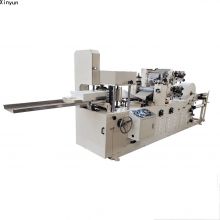Copyright © 2025 Fujian Xinyun Machinery Development Co.,Ltd. All rights reserved. Site Map
A napkin paper machine is a specialized industrial machine designed for the high-efficiency production of napkin paper products. These machines streamline the entire napkin production process, from cutting to folding and even printing, to meet various consumer demands. Equipped with automated functions, modern napkin paper machines produce high-quality products quickly, ensuring uniform thickness and a smooth finish.
Understanding the different types of napkin paper machines can help you select one that best fits your business needs.
a. Automatic Folding Napkin Paper Machine
This core machine automates the process of cutting and folding large paper rolls into finished napkin sizes. Models with automatic feeding systems reduce manual intervention and are ideal for high-speed production. Popular folding types include N-fold and Z-fold, both designed for optimal stacking.
b. Printing Napkin Paper Machine
This machine type is essential for creating custom napkin designs with logos or patterns. High-end models offer multicolor printing and fast pattern-switching, catering to custom orders that enhance product appeal for consumers and businesses alike.
c. Embossing Napkin Paper Machine
Embossing adds texture to the napkin, elevating its look and feel. Many napkin machines combine embossing with folding functions, creating napkins with intricate patterns that are perfect for the hospitality industry.
d. Packaging Napkin Paper Machine
For efficient packaging, automated packaging machines are invaluable. They seal napkins securely, keeping them clean during storage and transportation. These machines significantly reduce labor costs while ensuring consistent packaging quality.

Choosing the right napkin paper machine involves evaluating the following factors:
a. Production Speed and Efficiency
Production speed directly impacts output and operational efficiency. Modern napkin machines operate at speeds of 600 to 800 sheets per minute, making them suitable for high-demand markets.
b. Automation and Control Systems
Automation level is a crucial consideration; machines with PLC control systems handle tasks like feeding, folding, cutting, and printing with minimal manual oversight. Advanced models feature remote monitoring and error alerts, reducing labor costs and enhancing productivity.
c. Printing and Embossing Capabilities
If customization is key to your market strategy, consider machines that support multi-color printing and versatile embossing patterns. These features allow for quick adjustments, enhancing product variety and customer appeal.
d. After-Sales Support and Spare Parts Availability
Reliable after-sales support and readily available spare parts are essential for maintaining productivity and minimizing downtime. Reputable suppliers offer extensive support, ensuring the long-term operation of your investment.
The napkin production process generally includes the following steps:
Rewinding: Large rolls of raw paper are rewound to prepare for further processing.
Embossing and Printing: Paper is embossed or printed with custom designs.
Folding and Cutting: The folding machine cuts and folds the paper into napkins of preset sizes.
Automated Packaging: Finished napkins are packaged in secure, standardized packs for distribution.
Each step, enhanced by automation and precision engineering, contributes to a streamlined production line that maximizes output quality.
Global demand for napkin paper machines is growing due to increased usage in hospitality, food services, and retail sectors. Custom napkin production has also seen a rise, fueling the need for versatile machines that support high-efficiency, sustainable production. As more manufacturers adopt eco-friendly materials and energy-efficient designs, the industry is poised for continued growth, particularly in emerging markets.
Regular maintenance is vital for achieving maximum machine lifespan and efficiency. Here are key maintenance tips:
Cleaning and Lubrication: Regularly clean cutting blades and rollers to avoid debris buildup, and lubricate moving parts as recommended.
Electrical Inspections: Conduct regular inspections of the electrical system to prevent short circuits and maintain operational safety.
Blade Replacement: Replace cutting blades periodically to maintain precise cuts and prevent paper jams.
Calibration: Regularly calibrate the machine to ensure folding and printing accuracy.
Following these steps helps maintain productivity, reduce downtime, and extend the machine’s operational life.
Investing in the right napkin paper machine is crucial for any business seeking to produce high-quality paper products. By understanding machine types, essential purchasing factors, and proper maintenance practices, you can optimize production efficiency and product quality. As demand grows, leveraging advanced machinery with customizable features will be instrumental in meeting diverse consumer needs and staying competitive in the market.
By continuing to use the site you agree to our privacy policy.